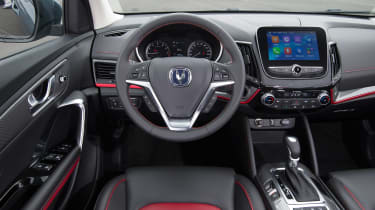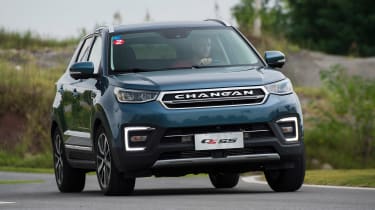New Changan CS55 2017 review
We head East to try the new Changan CS55 SUV - China’s latest Qashqai rival
Far from being cheap and nasty, the Changan CS55 is in fact a worthy competitor to many cars costing twice the price. The company’s bosses say they’ll prioritise the domestic market first before rolling out later models to Europe and the US, but initial feedback suggests a few choice changes would make the cars appeal to British buyers. On quality, comfort, space and style at least, Changan is more than halfway there.
Changan is the biggest global car manufacturer you’ve never heard of. The brand is more than 100 years old, in fact, and in 2016 alone produced nearly three million vehicles – including cars, vans and SUVs.
Most of these are sold in its home market of China, but with more than 6,000 service facilities across 60 countries worldwide, Changan also has a big presence in South America, the Middle East and Russia.
With new research and development centres in Italy, the US and even Britain, the company is ready to take its next step. Brand bosses suggest a European launch is still up to a decade away, but to see if Changan is ready to conquer established brands like Citroen, Hyundai, Kia and Renault, we took a trip to the firm’s headquarters in Chongqing for a test drive of its latest model – the CS55.
At 4.5m long and around 1.86m wide, the CS55 is similar in size to the current Nissan Qashqai. It’s offered only with a 1.5-litre turbo petrol engine, and power is sent to the front wheels through a six-speed automatic gearbox.
Used - available now

2024 BMW
2 Series Gran Coupe
20,431 milesAutomaticPetrol1.5L
Cash £22,099
2022 Volvo
S60
15,501 milesAutomaticPetrol2.0L
Cash £23,599
2021 Mercedes
A-Class Saloon
9,754 milesAutomaticDiesel2.0L
Cash £22,499
2023 Honda
CR-V
14,943 milesAutomaticPetrol2.0L
Cash £27,060Climb inside and it’s plusher and better equipped than you’d ever imagine a cheap Chinese SUV to be. Prices in Changan’s domestic market start at 83,900 Yuan (around £10,000), while flagship variants like the car we’re testing here top out at less than £17k.
Save the huge Changan badging on the nose, the styling is suitably European. There are hints of Land Rover Discovery to its front end, while the bold lines, jacked-up stance and sharp LED daytime running lights give it easily as much kerb appeal as a Renault Kadjar. The 18-inch alloy wheels and optional contrast roof offer buyers a welcome degree of personalisation, too. Chinese buyers are a fickle bunch, we’re told, and fashion is extremely important.
The cabin’s centrepiece is an eight-inch touchscreen, and while the overall perceived quality can’t rival an Audi or Mercedes, it’s easily on par with any of the Korean brands.
Google is blocked in China, so there is no Android Auto or Apple CarPlay functionality, but a system called BaiduCarlife will mirror your phone’s screen on the central display and give you access to maps, contacts and music. It’s Internet-ready, too, allowing access to real-time traffic information. Changan will have to come up with a more Euro-centric solution if it wants to expand into this region, of course.
In the back, the CS55 doesn’t feel as cleverly packaged as some of its rivals; a Peugeot 3008 is bigger, for example. There’s lots of knee room, though, and the lack of a transmission tunnel means a flat floor, so you’ll be able to fit three in the rear for short journeys. Changan was unable to provide an official boot space figure, but we’d suggest a Qashqai is likely to offer a larger load bay.
On the road, the Chinese preference for comfort over handling is immediately evident. While the CS55 is more agile than the larger CS95, the soft damping and lazy gearbox make quick progress difficult. The steering is reasonably direct and although there isn’t much feel (even in the car’s Sport setting), turn-in is sharp enough. Push too hard, however, and the wheels will push wide. A SEAT Ateca definitely feels more stable, more controllable and more fun.
Still, despite being short on involvement, the CS55 is perfectly comfortable. The downsized turbo engine is quiet, and at speed the biggest issue is road noise from the larger wheels. The soft damping means it struggles with sharp jolts, but you’ll rarely notice shudders in the cabin.
Don’t think of the CS55 as some kind of cheap Chinese knock-off, though. It’s packed to the rafters with safety kit, in fact, including adaptive cruise control, front collision warning, automatic emergency braking and six airbags. Lane-change assist, blind spot monitoring and rear collision warning also feature, alongside tyre-pressure monitoring and a 360-degree parking camera. That’s easily as comprehensive as any of Changan’s European rivals.
Not content with simply matching its competitors, the firm provides a 10-year, 260,000km (161,500-mile) warranty that looks impressive in any company. There’s no guarantee that UK cars would come with the same policy, of course, but this shows considerable confidence in the product.











